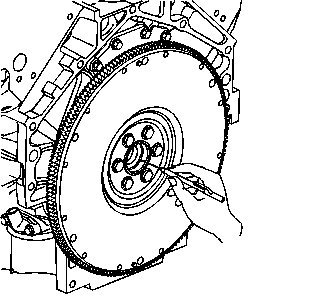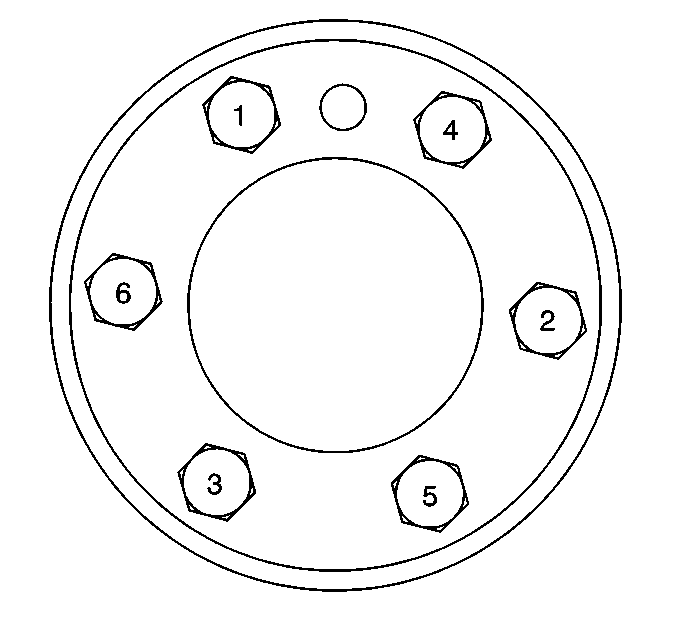Removal Procedure
Notice: Failure to follow the proper removal and installation procedures may result in damage to the engine crankshaft thrust bearing.
Notice: When tilting down the rear of the driveline, observe the clearance between the rear of the engine and the composite dash panel. Do not allow the engine to rest unsupported against the composite dash panel, or vehicle damage may result.
Notice: When lowering and removing the rear of the driveline, observe the clearance between the rear of the transaxle assembly and the underbody to prevent damage.
Important:
• For manual transmission applications, note the position and direction
of the engine flywheel before removal. The flywheel does not use a locating pin
for alignment. Mark or scribe the end of the crankshaft and the flywheel before
component removal. The engine flywheel must be reinstalled to the original position
and direction. The engine flywheel will not initially seat against the crankshaft
flange, but will be pulled onto the crankshaft by the engine flywheel bolts. This
procedure requires a 3 stage tightening process. • DO NOT remove the prop shaft hub or flex plate from the automatic transmission
engine flywheel. The flywheel, prop shaft hub, and flex plate are balanced as an
assembly. If service is required, the entire flywheel assembly should be replaced.
- Remove the catalytic converter. Refer to Catalytic Converter Replacement in Engine Exhaust.
- Remove the driveline support, if equipped with a automatic transmission. Refer to Driveline Support Assembly Replacement in Propeller Shaft.
- Remove the clutch pressure plate and clutch driven plate, if equipped with a manual transmission. Refer to Clutch Pressure Plate and Clutch Driven Plate in Clutch.
- Mark or scribe the end of the crankshaft and the manual transmission flywheel.
- If equipped with an automatic transmission, remove the engine flywheel bolts.
- If equipped with a manual transmission, remove the engine flywheel bolts.
- Remove the engine flywheel.
- Clean and inspect the engine flywheel. Refer to Engine Flywheel Cleaning and Inspection in Engine Mechanical-5.7L Unit Repair.

Refer to Engine Balancing


Installation Procedure
Important: For manual transmission applications, note the position and direction of the engine flywheel before removal. The flywheel does not use a locating pin for alignment. Mark or scribe the end of the crankshaft and the flywheel before component removal. The engine flywheel must be reinstalled to the original position and direction. The engine flywheel will not initially seat against the crankshaft flange, but will be pulled onto the crankshaft by the engine flywheel bolts. This procedure requires a 3 stage tightening process.
DO NOT remove the prop shaft hub or flex plate from the automatic transmission engine flywheel. The flywheel, prop shaft hub, and flex plate are balanced as an assembly. If service is required, the entire flywheel assembly should be replaced.- If equipped with a manual transmission, align the mark or scribe on the crankshaft with the mark or scribe on the existing flywheel.
- Install the engine flywheel.
- Apply threadlock GM P/N 12345382 or equivalent to the threads of the flywheel bolts.
- Install the engine flywheel bolts until snug.
- Tighten the engine flywheel bolts a first pass in sequence to 20 N·m (15 lb ft).
- Tighten the engine flywheel bolts a second pass in sequence to 50 N·m (37 lb ft).
- Tighten the engine flywheel bolts a final pass in sequence to 100 N·m (74 lb ft).
- Install the driveline support, if equipped with a automatic transmission. Refer to Driveline Support Assembly Replacement in Propeller Shaft.
- Install the clutch pressure plate and clutch driven plate, if equipped with a manual transmission. Refer to Clutch Pressure Plate and Clutch Driven Plate in Clutch.
- Install the catalytic converter. Refer to Catalytic Converter Replacement in Engine Exhaust.

Refer to Engine Balancing


Notice: Use the correct fastener in the correct location. Replacement fasteners must be the correct part number for that application. Fasteners requiring replacement or fasteners requiring the use of thread locking compound or sealant are identified in the service procedure. Do not use paints, lubricants, or corrosion inhibitors on fasteners or fastener joint surfaces unless specified. These coatings affect fastener torque and joint clamping force and may damage the fastener. Use the correct tightening sequence and specifications when installing fasteners in order to avoid damage to parts and systems.
Tighten
